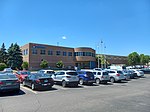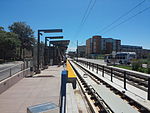KMNV
1936 establishments in MinnesotaRadio stations established in 1936Radio stations in Minneapolis–Saint PaulSpanish-language radio stations in Minnesota
KMNV (1400 kHz "La Raza") is a commercial AM radio station licensed to St. Paul, Minnesota, and serving the Twin Cities radio market. It is owned by Santamaria Broadcasting and broadcasts a Spanish-language radio format featuring Regional Mexican music with some weekday comedy shows. KMNV's radio studios and offices are in Richfield.KMNV is powered at 1,000 watts non-directional. The transmitter is near the Mississippi River in St. Paul. Programming is also heard on FM translator K239CJ at 95.7 MHz in St. Paul.
Excerpt from the Wikipedia article KMNV (License: CC BY-SA 3.0, Authors).KMNV
West Frontenac Place, Saint Paul Union Park
Geographical coordinates (GPS) Address Phone number Website Nearby Places Show on map
Geographical coordinates (GPS)
| Latitude | Longitude |
|---|---|
| N 44.95797 ° | E -93.206767 ° |
Address
Minnesota Public Radio
West Frontenac Place 611
55104 Saint Paul, Union Park
Minnesota, United States
Open on Google Maps








